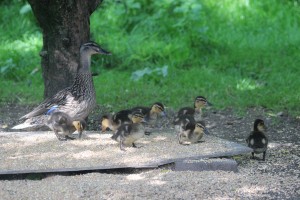 Despite the very poor weather this summer, the small birds in the garden, as reported in a previous article, did well. Siskins, house sparrows, greenfinches and yellowhammers all brought off second broods. The results can be seen on the feeders that have never been so busy since the spring. But what of the other garden birds? The biggest disappointment of all has been the house martins as apart from one pair they have just not turned up. The same can be said for the rest of the nearby village as although the number of swallows seem the same as every other year where are the house martins? Last year there were seven pairs under the eaves of our house which is low compared with previous years when the maximum was over twenty pairs. The solitary pair’s chicks have just fledged but I do not hold up much hope of a second brood.
Despite the very poor weather this summer, the small birds in the garden, as reported in a previous article, did well. Siskins, house sparrows, greenfinches and yellowhammers all brought off second broods. The results can be seen on the feeders that have never been so busy since the spring. But what of the other garden birds? The biggest disappointment of all has been the house martins as apart from one pair they have just not turned up. The same can be said for the rest of the nearby village as although the number of swallows seem the same as every other year where are the house martins? Last year there were seven pairs under the eaves of our house which is low compared with previous years when the maximum was over twenty pairs. The solitary pair’s chicks have just fledged but I do not hold up much hope of a second brood.
The great spotted woodpeckers and house martins at least have some safety in their respective nests until they actually fly. Not so the ground nesting birds and the pheasants are a good example where it seems to have all gone wrong this year. We have had up to ten adult female pheasants in the garden this summer, all coming in for the mixed grain. It was not until the last day of July that there was any sign of chicks and one female turned up with one very tiny chick. It had probably hatched two days before as it was so young. They lay their eggs in a scrape on the ground so are open to a very wide range of predators from crows to stoats.
In contrast there have been three pairs of great spotted woodpeckers and they all seem to have brought off two or three young. The juveniles can easily be identified as they have a deep red cap over their heads. We have judged there to be three pairs as, although they do not actually nest in the garden, all three pairs of adults went off in different directions from the feeders into the birch wood above the house. In the last week or so they have not been coming in anywhere near as much as there is more food elsewhere. This ranges from the bulk of their summer food, insects, to using their long tongues to reach for larvae inside trees. They are not averse to taking chicks of other birds such as in nestboxes and they will chip their way in using their very strong beaks.
Another ground nesting bird is the mallard and they too face the predators that the pheasants face. However, they do seem to have fared a little better. At present there is one brood of well grown ducklings, almost as big as the female that still ushers them around. Then a female with only two tiny ducklings and a female with seven larger ducklings. The photograph I took, in the garden, is of the female mallard that has seven ducklings and you can see that she is guarding them and ever watchful for predators. Twice a day she walks up with them from the garden pond about forty yards away. The route is along a steep path and then round two sheds to reach the mixed grain. Despite having left the pond, when the ducklings have finished eating they go over to the sunken bird bath and drink before washing themselves. The female then ushers them back along the same path to the pond. She started with seven and still had the same number the last time I saw her.
Tags: highland birds
